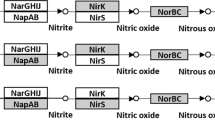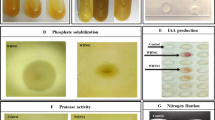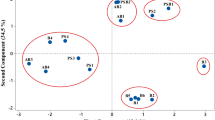Abstract
Certain H2-oxidizing rhizobacteria promote the growth of legume plants nodulated with rhizobia devoid of an uptake hydrogenase system (Hup−). We demonstrated and assessed the plant growth-promoting ability of H2-oxidizing rhizobacteria naturally associating with lentil roots nodulated by rhizobia possessing an uptake hydrogenase system (Hup+ lentil) in semiarid Canada. The ten H2-oxidizing rhizobacteria isolated were strains of Variovorax paradoxus, Variovorax sp., Rhodococcus sp., Mycobacterium sp., Acinetobacter sp., Acinetobacter calcoaceticus, and Curtobacterium sp. Several of these strains increased Hup+ lentil shoot and root biomasses, and root nodule number in the absence or presence of drought stress. Inoculation with H2-oxidizing rhizobacteria enhanced the growth of Hup+ lentil infected by the fungal root pathogens Fusarium avenaceum, Rhizoctonia solani, and Pythium ultimum. Fusarium avenaceum growth was markedly suppressed by all H2-oxidizing rhizobacteria in vitro, and seven isolates also suppressed the growth of both R. solani and P. ultimum. Siderophore production was detected in nine isolates and one isolate could solubilize phosphate. Indole-3-acetic acid production was found in four isolates, and 1-aminocyclopropane-1-carboxylate deaminase activity in six isolates. Most H2-oxidizing rhizobacterial isolates exhibited multiple plant growth-promoting attributes and all isolates exhibited at least one. Our results suggest that the H2-oxidizing rhizobacteria naturally associating with lentil roots in semiarid Canada are beneficial in an Hup+ environment.





Similar content being viewed by others
References
Abd El Daim IA, Häggblom P, Karlsson M, Stenström E, Timmusk S (2014) Paenibacillus polymyxa A26 Sfp-type PPTase inactivation limits bacterial antagonism against Fusarium graminearum but not of F. culmorum in kernel assay. Front Plant Sci. 6:368. doi:10.3389/fpls.2015.00368
Annan H, Golding A-L, Zhao Y, Dong Z (2012) Choice of hydrogen uptake (Hup) status in legume-rhizobia symbioses. Ecol Evol 2:2285–2290
Antoun H, Beauchamp C, Goussard N, Chabot R, Lalande R (1998) Potential of Rhizobium and Bradyrhizobium species as plant growth promoting rhizobacteria on non-legumes: effect on radishes (Raphanus sativus L.). Plant Soil 204:57–67
Arshad M, Saleem M, Hussain S (2007) Perspectives of bacterial ACC deaminase in phytoremediation. Trends Biotechnol 25:356–362
Bai Y, Zhou X, Smith DL (2003) Enhanced soybean plant growth resulting from coinoculation of Bacillus strains with Bradyrhizobium japonicum. Crop Sci 43:1774–1781
Banchio E, Bogino PC, Zygadlo J, Giordano W (2008) Plant growth promoting rhizobacteria improve growth and essential oil yield in Origanum majorana L. Bioch Syst Ecol 36:766–771
Bano N, Musarrat J (2003) Characterization of a new Pseudomonas aeruginosa Strain NJ-15 as a potential biocontrol agent. Curr Microbiol 46:0324–0328
Belimov A, Safronova V, Sergeyeva T, Egorova T, Matveyeva V, Tsyganov V, Borisov A, Tikhonovich I, Kluge C, Preisfeld A, Dietz K, Stepanok V (2001) Characterization of plant growth promoting rhizobacteria isolated from polluted soils and containing 1-aminocyclopropane-1-carboxylate deaminase. Can J Microbiol 47:642–652
Belimov AA, Dodd IC, Hontzeas N, Theobald JC, Safronova VI, Davies WJ (2009) Rhizosphere bacteria containing 1-aminocyclopropane-1-carboxylate deaminase increase yield of plants grown in drying soil via both local and systemic hormone signalling. New Phytol 181:413–423
Bulgarelli D, Schlaeppi K, Spaepen S, Van Themaaf EVL, Schulze-Lefert P (2013) Structure and function of the bacterial microbiota of plants. Ann Rev Plant Biol 64:807–838
Canadian Agri-Food Trade Alliance (2016) Pulses. http://cafta.org/pages/agri-food-exports/pulses/
Chen L, Dodd IC, Theobald JC, Belimov AA, Davies WJ (2013) The rhizobacterium Variovorax paradoxus 5C-2, containing ACC deaminase, promotes growth and development of Arabidopsis thaliana via an ethylene-dependent pathway. J Bot 64:1565–1573
Dean CA, Sun W, Dong Z, Caldwell CD (2006) Soybean nodule hydrogen metabolism affects soil hydrogen uptake and growth of rotation crops. Can J of Plant Sci 86:1355–1359
Dong Z, Layzell DB (2001) H2 oxidation, O2 uptake and CO2 fixation in hydrogen treated soils. Plant Soil 229:1–12
Dong Z, Layzell DB (2002) Why do legume nodules evolve hydrogen gas? In: Finan T, O’Brian M, Layzell D, Vessey K, Newton W (eds) Nitrogen fixation, global perspectives. CABI, New York, pp 331–335
Dong Z, Wu L, Kettlewell B, Caldwell CD, Layzell DB (2003) Hydrogen fertilization of soils—is this a benefit of legumes in rotation? Plant Cell Environ 26:1875–1879
Dworkin M, Foster JW (1958) Experiments with some microorganisms which utilize ethane and hydrogen. J Bacteriol 75:592–603
Erskine W, Sarker A, Kumar S (2011) Investing in lentil improvement toward a food secure world. Food Secur 3(2):127–139
Fernández D, Toffanin A, Palacios JM, Ruiz-Argüeso T, Imperial J (2005) Hydrogenase genes are uncommon and highly conserved in Rhizobium leguminosarum bv. viciae. FEMS Microbiol Lett 253:83–88
Figueiredo MVB, Burity HA, Martínez CR, Chanway CP (2008) Alleviation of drought stress in the common bean (Phaseolus vulgaris L.) by co-inoculation with Paenibacillus polymyxa and Rhizobium tropici. Appl Soil Ecol 40:182–188
Findenegg G, Nelemans J (1993) The effect of phytase on the availability of P from myo-inositol hexaphosphate (phytate) for maize roots. Plant Soil 154:189–196
Gan Y, Liang C, Hamel C, Cutforth H, Wang H (2011) Strategies for reducing the carbon footprint of field crops for semiarid areas. A review. Agron Sustain Dev 31:643–656
Giongo A, Beneduzi A, Gano K, Vargas LK, Utz L, Passaglia LMP (2013) Characterization of plant growth-promoting bacteria inhabiting Vriesea gigantea Gaud. and Tillandsia aeranthos (Loiseleur) L.B. Smith (Bromeliaceae). Biota Neotrop 13:80–85
Glick BR, Penrose DM, Li J (1998) A model for the lowering of plant ethylene concentrations by plant growth-promoting bacteria. Theor Biol 190:63–68
Glick BR, Todorovic B, Czarny J, Cheng Z, Duan J, McConkey B (2007) Promotion of plant growth by bacterial ACC deaminase. Crit Rev Plant Sci 26:227–242
Goldstein A (2007) Future trends in research on microbial phosphate solubilization: one hundred years of insolubility. In: Velázquez E, Rodríguez-Barrueco C (eds). First International Meeting on Microbial Phosphate Solubilization. Vol 102 of the series Developments in Plant and Soil Sciences. Springer, Netherlands, pp 91–96
Gupta A, Saxena AK, Gopal M, Tilak KVBR (1998) Effect of plant growth promoting rhizobacteria on competitive ability of introduced Bradyrhizobium sp. (Vigna) for nodulation. Microbiol Res 153:113–117
Haas D, Defago G (2005) Biological control of soil-borne pathogens by fluorescent pseudomonads. Nat Rev Microbiol 3:307
Huddedar S, Shete A, Tilekar J, Gore S, Dhavale D, Chopade B (2002) Isolation, characterization, and plasmid pUPI126-mediated indole-3-acetic acid production in Acinetobacter strains from rhizosphere of wheat. Appl Biochem Biotech 102–103:21–39
Hunter WJ (1993) Ethylene production by root nodules and effect of ethylene on nodulation in Glycine max. Appl Environ Microbiol 59:1947–1950
Hynes RK, Leung GCY, Hirkala DLM, Nelson LM (2008) Isolation, selection, and characterization of beneficial rhizobacteria from pea, lentil, and chickpea grown in western Canada. Can J Microbiol 54:248–258
Iqbal MA, Khalid M, Shahzad SM, Ahmad M, Soleman N, Akhtar N (2012) Integrated use of Rhizobium leguminosarum, plant growth promoting rhizobacteria and enriched compost for improving growth, nodulation and yield of lentil (Lens culinaris Medik.). Chil J Agric Res 72(1):104
Irvine P, Smith M, Dong Z (2004) Bacteria or fungi? Acta Hort 631:239–242
Jiang F, Chen L, Belimov AA, Shaposhnikov AI, Gong F, Meng X, Hartung W, Jeschke DW, Davies WJ, Dodd IC (2012) Multiple impacts of the plant growth-promoting rhizobacterium Variovorax paradoxus 5C-2 on nutrient and ABA relations of Pisum sativum. J Exp Bot 63:6421–6430
John P, Whatley FR (1977) The bioenergetics of Paracoccus denitrificans. BBA Rev Bioenerg 463:129–153
Jorquera M, Hernandez M, Rengel Z, Marschner P, Mora M (2008) Isolation of culturable phosphobacteria with both phytate-mineralization and phosphate-solubilization activity from the rhizosphere of plants grown in a volcanic soil. Biol Fertil Soils 44:1025–1034
Kang S-M, Khan A, Hamayun M, Shinwari ZK, Kim Y-H, Joo G, Lee I-J (2012) Acinetobacter calcoaceticus ameliorated plant growth and influenced gibberellins and functional biochemicals. Pak J Bot 44:365–372
Kazan K, Manners JM (2009) Linking development to defense: auxin in plant–pathogen interactions. Trends Plant Sci 14:373–382
Kim D, Kim Y-S, Kim S-K, Kim SW, Zylstra GJ, Kim YM, Kim E (2002) Monocyclic aromatic hydrocarbon degradation by Rhodococcus sp. Strain DK17. Appl Environ Microbiol 68:3270–3278
Kloepper JW, Leong J, Teintze M, Schroth MN (1980) Enhanced plant growth by siderophores produced by plant growth-promoting rhizobacteria. Nature 286:885–886
Kramer PJ, Boyer JS (1995) Water relations of plants and soils. Academic Press, New York
Lambert GR, Hanus FJ, Sterling RA, Evans HJ (1985) Determination of the hydrogenase status of individual legume nodules by a methylene blue reduction assay. Appl Environ Microbiol 50:537–539
Larrainzar E, Molenaar JA, Wienkoop S, Gil-Quintana E, Alibert B, Limami AM, Arrese-Igor C, González EM (2014) Drought stress provokes the down-regulation of methionine and ethylene biosynthesis pathways in Medicago truncatula roots and nodules. Plant Cell Environ 37:2051–2063
Laslo É, György É, Mara G, Tamás É, Ábrahám B, Lányi S (2012) Screening of plant growth promoting rhizobacteria as potential microbial inoculants. Crop Prot 40:43–48
Maimaiti J, Zhang Y, Yang J, Cen YP, Layzell D, Peoples M, Dong Z (2007) Isolation and characterization of hydrogen-oxidizing bacteria induced following exposure of soil to hydrogen gas and their impact on plant growth. Environ Microbiol 9:435–444
Mathiyazhagan S, Kavitha K, Nakkeeran S, Chandrasekar G, Manian K, Renukadevi P, Krishnamoorthy AS, Fernando WGD (2004) PGPR mediated management of stem blight of Phyllanthus amarus (Schum and Thonn) caused by Corynespora cassiicola (Berk and Curt) Wei. Arch Phytopathol Plant Prot 37:183–199
Mayak S, Tirosh T, Glick BR (2004) Plant growth-promoting bacteria that confer resistance to water stress in tomatoes and peppers. Plant Sci 166:525–530
McSpadden GB, Fravel D (2002) Biological control of plant pathogens: research, commercialization, and application in the USA. Plant Health Prog. doi:10.1094/PHP-2002-0510-01-RV
Mirza BS, Mirza MS, Bano A, Malik KA (2007) Coinoculation of chickpea with Rhizobium isolates from roots and nodules and phytohormone-producing Enterobacter strains. Aust J Exp Agric 47:1008–1015
Nascimento F, Brígido C, Alho L, Glick BR, Oliveira S (2012) Enhanced chickpea growth-promotion ability of a Mesorhizobium strain expressing an exogenous ACC deaminase gene. Plant Soil 353:221–230
Nelson LM (2004) Plant growth promoting rhizobacteria (PGPR): prospects for new inoculants. Crop Manag. doi:10.1094/CM-2004-0301-05-RV
Nguyen C, Yan W, Le Tacon F, Lapeyrie F (1992) Genetic variability of phosphate solubilizing activity by monocaryotic and dicaryotic mycelia of the ectomycorrhizal fungus Laccaria bicolor (Maire) P.D. Orton. Plant Soil 143:193–199
Patten CL, Glick BR (2002) Role of Pseudomonas putida indoleacetic acid in development of the host plant root system. Appl Environ Microbiol 68:3795–3801
Richardson A (2001) Prospects for using soil microorganisms to improve the acquisition of phosphorus by plants. Aust J Plant Physiol 28:897–906
Richardson A, Barea J, McNeill A, Prigent-Combaret C (2009) Acquisition of phosphorus and nitrogen in the rhizosphere and plant growth promotion by microorganisms. Plant Soil 321:305–339
Rodríguez H, Fraga R (1999) Phosphate solubilizing bacteria and their role in plant growth promotion. Biotechnol Adv 17:319–339
Sakunpon N, Boonkerd N, Teaumroong N, Okazaki S, Tittabutr P (2014) Influence of H2 and plant growth promoting rhizobacteria (PGPR) containing uptake hydrogenase on soybean growth promotion. Int Proc Chem Biol Environ Eng 70:147
Sarode PD, Rane MR, Chaudhari BL, Chincholkar SB (2009) Siderophoregenic Acinetobacter calcoaceticus isolated from wheat rhizosphere with strong PGPR activity. J Microbiol 5:6–12
Satola B, Wübbeler JH, Steinbüchel A (2012) Metabolic characteristics of the species Variovorax paradoxus. Appl Microbiol Biotechnol 97:541–560
Schlegel H, Meyer M (1985) Isolation of hydrogenase regulatory mutants of hydrogen-oxidizing bacteria by a colony-screening method. Arch Microbiol 141:377–383
Schwyn B, Neilands JB (1987) Universal chemical assay for the detection and determination of siderophores. Anal Biochem 160:47–56
Shaharoona B, Arshad M, Zahir ZA (2006) Effect of plant growth promoting rhizobacteria containing ACC-deaminase on maize (Zea mays L.) growth under axenic conditions and on nodulation in mung bean (Vigna radiata L.). Lett Appl Microbiol 42:155–159
Shahzad S, Khalid A, Arshad M, Kalil-ur R (2010) Screening rhizobacteria containing ACC-deaminase for growth promotion of chickpea seedlings under axenic conditions. Soil Environ 29:38–46
Simpson FB, Burris RH (1985) A nitrogen pressure of 50 atmospheres does not prevent evolution of hydrogen by nitrogenase. Science 224:1095–1097
Spaepen S, Vanderleyden J, Remans R (2007) Indole-3-acetic acid in microbial and microorganism-plant signaling. FEMS Microbiol Rev 31:425–448
Valentine AJ, Osborne BA, Mitchell DT (2001) Interactions between phosphorus supply and total nutrient availability on mycorrhizal colonization, growth and photosynthesis of cucumber. Sci Hortic 88:177–189
Vanderhoef LN, Dute RR (1981) Auxin regulated wall loosening and sustained growth in elongation. Plant Physiol 67:146–149
Vansuyt G, Robin A, Briat J-F, Curie C, Lemanceau P (2007) Iron acquisition from Fe-pyoverdine by Arabidopsis thaliana. Mol Plant Microb Interact 20:441–447
Vassilev N, Vassileva M, Nikolaeva I (2006) Simultaneous P-solubilizing and biocontrol activity of microorganisms: potentials and future trends. Appl Microbiol Biotechnol 71:137–144
Watanabe K, Kodama Y, Harayama S (2001) Design and evaluation of PCR primers to amplify bacterial 16S ribosomal DNA fragments used for community fingerprinting. J Microbiol Methods 44:253–262
Xiang S, Yao T, An L, Xu B, Wang J (2005) 16S rRNA sequences and differences in bacteria isolated from the Muztag Ata glacier at increasing depths. Appl Environ Microbiol 71:4619–4627
Yagi T, Higuchi Y (2012) Studies on hydrogenase. Proc Jpn Acad Ser B 89:16–32
Yang C (2012) Response of rhizobacterial community to agronomic practices in chickpea field, and its effects on pulse-cereal rotation system. PhD Dissertation, University of Saskatchewan. http://hdl.handle.net/10388/ETD-2012-03-367
Yang C, Hamel C, Gan Y, Vujanovic V (2012) Bacterial endophytes mediate positive feedback effects of early legume termination times on the yield of subsequent durum wheat crops. Can J Microbiol 58:1368–1377
Zafar M, Abbasi MK, Khan MA, Khaliq A, Sultan T, Aslam M (2012) Effect of plant growth-promoting rhizobacteria on growth, nodulation and nutrient accumulation of lentil under controlled conditions. Pedosphere 22:848–859
Zahir Z, Ghani U, Naveed M, Nadeem S, Asghar H (2009) Comparative effectiveness of Pseudomonas and Serratia sp. containing ACC-deaminase for improving growth and yield of wheat (Triticum aestivum L.) under salt-stressed conditions. Arch Microbiol 191:415–424
Zhang Y (2006) Mechanisms of isolated hydrogen-oxidizing bacteria in plant growth promotion and effects of hydrogen metabolism on rhizobacterial community structure. Master’s Thesis, Saint Mary’s University, Halifax
Acknowledgements
This research was supported by Saskatchewan’s Agriculture Development Fund and Saskatchewan Pulse Growers.
Author information
Authors and Affiliations
Corresponding authors
Rights and permissions
About this article
Cite this article
Abdellatif, L., Ben-Mahmoud, O.M., Yang, C. et al. The H2-oxidizing Rhizobacteria Associated with Field-Grown Lentil Promote the Growth of Lentil Inoculated with Hup+ Rhizobium Through Multiple Modes of Action. J Plant Growth Regul 36, 348–361 (2017). https://doi.org/10.1007/s00344-016-9645-7
Received:
Accepted:
Published:
Issue Date:
DOI: https://doi.org/10.1007/s00344-016-9645-7




